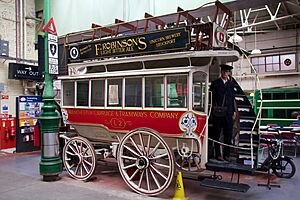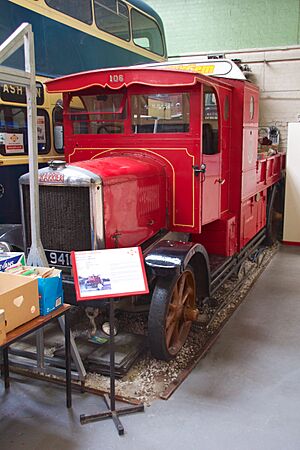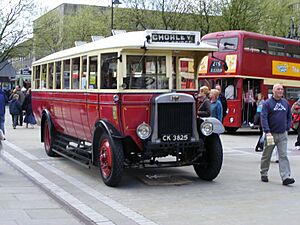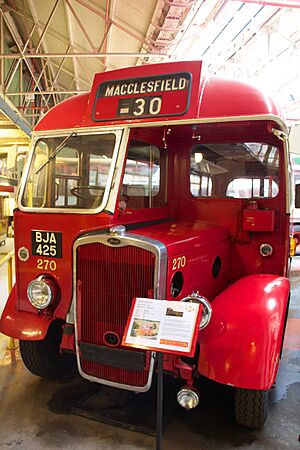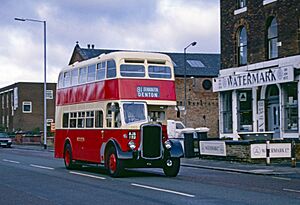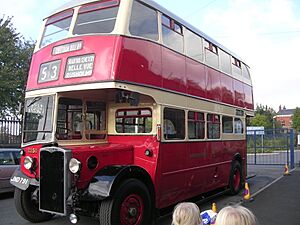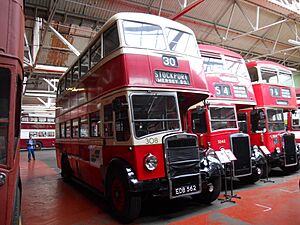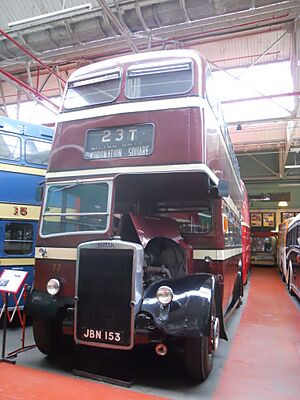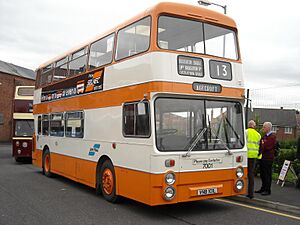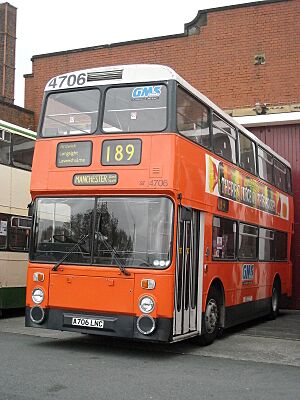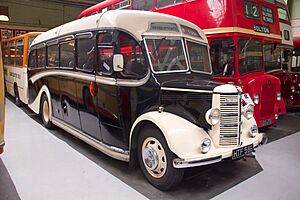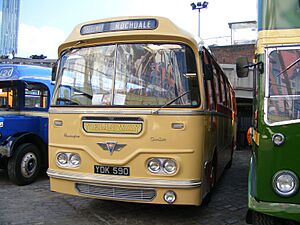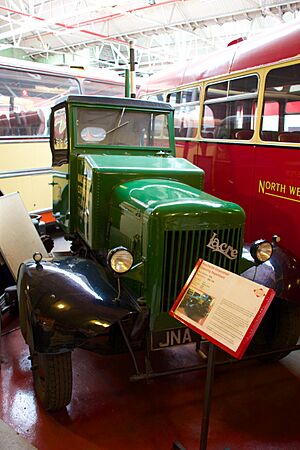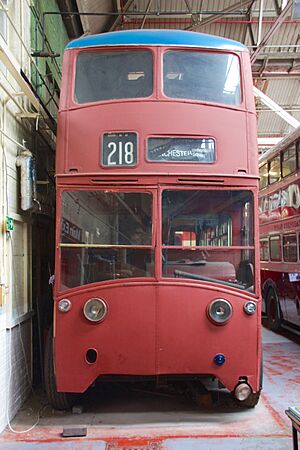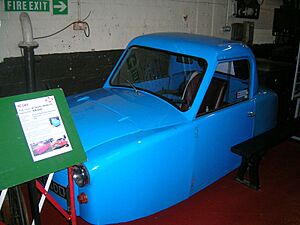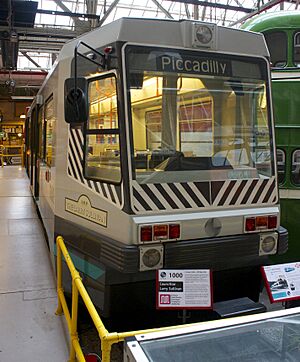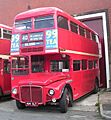List of vehicles at the Museum of Transport, Greater Manchester facts for kids
The Museum of Transport, Greater Manchester is home to an amazing collection of vehicles that tell the story of how people moved around Greater Manchester over the years. From old horse-drawn buses to modern electric trams, this museum shows off some really cool machines! It's like a time capsule of travel, letting you see how transport has changed and improved.
Contents
Journey Through Time: Early Transport
Imagine a time before cars and big buses! The museum has vehicles from the very beginning of public transport.
Horse-Powered Journeys
Before engines, horses did all the hard work!
- Horse Bus (1890): One of the oldest vehicles is a horse bus from the Manchester Carriage and Tramways Company. This bus, named L2, would have been pulled by horses, carrying people around the city. It shows how simple public transport started.
First Trams and Special Vehicles
As technology grew, so did the vehicles.
- Early Tram (1906): The museum also has an early tram from the South Lancashire Tramways. Trams were a big step up from horse buses, running on tracks and often powered by electricity.
- Recovery Vehicle (1926): Even in the early days, vehicles broke down! The museum has a recovery vehicle, like a tow truck, from Stockport Corporation Transport. This vehicle, YM 9410, helped fix or move other vehicles that got stuck.
Buses Through the Decades
Buses are a huge part of Manchester's transport history, and the museum has many different types from various eras.
Single Deck Buses
These buses were common for shorter routes or when fewer people needed to travel.
- Ribble Bus (1927): A single deck bus, C295, from Ribble Motor Services shows what buses looked like almost a hundred years ago.
- Manchester Corporation Bus (1930): The Manchester Corporation Transport also had single deck buses, like VR 5742, which served the city's residents.
- North Western Bus (1946): Another single deck bus, BJA 425, from the North Western Road Car Company (1923) is part of the collection, showing how bus designs evolved after World War II.
Double Deck Buses
Double deckers are iconic, especially in British cities, allowing more passengers to travel at once.
- North Western Double Decker (1939): A double deck bus, AJA 152, from the North Western Road Car Company (1923) shows the early designs of these tall buses.
- Manchester Corporation Bus (1949): The museum has several Manchester Corporation double deckers, like JND 791, which were a common sight in the city after the war.
- Stockport Corporation Bus (1951): Stockport also had its own fleet, including EDB 562, a double deck bus that served its community.
- Bolton Corporation Bus (1956): JBN 153 is a double deck bus from Bolton Corporation Transport, showing the variety of operators in the region.
- Manchester's Iconic Atlantean (1968): The Leyland Atlantean was a very important bus model. The museum has Manchester Corporation's 1001, HVM 901F, which was a key part of modernizing bus fleets.
- SELNEC Bus (1972): The SELNEC Passenger Transport Executive took over many local bus companies. Their Leyland Atlantean, VNB 101L, was one of the first buses designed for easier passenger flow.
- Modern Double Decker (1984): The museum also showcases more recent double deck buses, like A706 LNC from Greater Manchester Transport, showing how buses continued to change.
Coaches and Minibuses
Beyond regular city buses, the museum also has vehicles for longer journeys or smaller groups.
- Single Deck Coach (1947): Coaches, like HTF 586 from Warburton Bros (Bury) Ltd, were used for longer trips or tours.
- Yelloway Coach (1961): Yelloway was a well-known coach operator. Their coach, YDK 590, represents the era of comfortable long-distance travel.
- Minibus (1986): For smaller routes or fewer passengers, minibuses became popular. The museum has D63 NOF from The Bee Line Buzz Company, showing this trend.
Special Purpose Vehicles
Not all vehicles at the museum were for carrying passengers. Some had very important jobs!
Emergency and Utility Vehicles
These vehicles kept the city running and safe.
- Fire Engine (1941): A bright red fire engine, BRJ 333, from the Salford Corporation Fire Brigade is a highlight. It reminds us of the brave firefighters who used these machines.
- Lorry (1946): Lorries, like AHL 622 from Beverley's Beers, were essential for moving goods and supplies around the region.
- Road Sweeper (1948): Keeping streets clean was important! The museum has a road sweeper, JNA 256, from the Manchester Corporation Cleansing Department.
Unique Transport
Some vehicles represent specific types of transport that were once common or very specialized.
- Trolleybus (1950): A trolleybus, LTC 774, from Ashton-under-Lyne Corporation Passenger Transport is a special exhibit. These buses ran on electricity from overhead wires, a bit like trams but without tracks on the road.
- Invacar (1966): The museum even has a unique car, NPB 840D, called an Invacar. These small, three-wheeled vehicles were specially designed to help people with disabilities get around.
- Light Rail Vehicle (1990): Looking towards modern transport, the museum has a prototype light rail vehicle, 1000, from Manchester Metrolink. This shows the shift towards modern tram systems.
The Museum of Transport, Greater Manchester, offers a fantastic look at how people and goods have moved around the region for over a century. It's a great place to see these historic machines up close!
Images for kids


